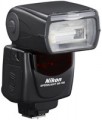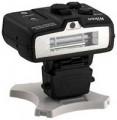Guide number
The guide number is the main characteristic that describes the power of the light pulse of the flash. It is described as the maximum distance (in metres) at which, at ISO 100 and f/1 lens speed (aperture 1), a flash is able to illuminate an "average" subject sufficiently for a normal exposure; in other words, at what distance from the flash it will be possible to normally shoot the scene at the specified ISO and aperture.
There are formulas by which, knowing the guide number, you can derive the practical shooting distance for each specific value of sensitivity and aperture. The simplest formula used to calculate the distance at ISO 100 is: S=N/f, where S is the distance, N is the guide number, f is the aperture value. For example, for a guide number of 56 and an f/2.8 lens, this distance would be 56/2.8 = 20 m. Increasing or decreasing sensitivity by a factor of 2 would increase or decrease the specified distance by approximately 1.4 times, respectively. If you need to calculate the distance as accurately as possible, you should refer to more detailed formulas that can be found in specialized sources.
Separately, it is worth noting that the leading numbers of flashes, usually, are indicated by manufacturers for specific focal lengths of lenses. This is due to the fact that the shorter the focal length and, accordingly, the wider the viewing angle, the more light is needed to illuminate the scene being shot and the more powerful the flash pulse should b...e (at the same distance). Therefore, when choosing by the guide number, it makes sense to pay attention to the focal length indicated by the manufacturer and select a model with a power reserve — especially since guide numbers are often prescribed for rather “long-range” lenses (with a focal length of about 80-100 mm in equiv. 35 mm).
Reload time
The time it takes the flash or generator (for studio flashes) to prepare for the next flash. The smaller it is, the better. This parameter is especially important for continuous shooting, when the interval between frames is small: if you often shoot in this mode, you should look for a flash with the shortest possible recycle time. Also note that the characteristics usually indicate the shortest recharge time; in some operating modes, it may be significantly more than stated.
Number of impulses
The number of flashes that the flash can fire without recharging the battery or changing batteries (see "Power"). This parameter is very approximate, because. in fact, it strongly depends on a number of factors: pulse duration, use of the display and its backlight (if any, see below), autofocus backlight (see "Features"), etc., and with replaceable batteries — even and on their quality. Often, manufacturers indicate in the characteristics the “perfect”, the maximum possible number of pulses — i.e. with their minimum duration, non-use of additional functions and even the optimal temperature regime for the battery. In reality, this figure may be lower. Nevertheless, the data indicated in the characteristics makes it quite possible to evaluate the battery life of the flash and even compare different models with each other.
Beam angle
The angle at which the main beam of light from the flash diverges. This parameter is not expressed directly, in degrees, but in terms of the focal lengths of the corresponding lenses, in millimetres: for example, a beam angle of 105 mm corresponds to the angle of view of a lens with the same focal length (35 mm equivalent). This makes it easy to select a flash for specific optics, so that it most effectively illuminates all the space in the frame. And the most advanced modern flashes can have a variable dispersion angle, allowing you to adjust them to different shooting features; this feature is especially useful when using zoom lenses. Changing the angle of dispersion is carried out by a movable lens installed in the flash head, it can be carried out both automatically and manually (for more details, see "Functions and Capabilities").
Features
—
Autofocus assist light. The presence of an auxiliary illumination function in the flash for the camera's autofocus system. Modern cameras in the vast majority use the so-called passive autofocus systems, which have one serious drawback: very low efficiency in low light and/or low contrast of the subject being photographed. Autofocus assist light is designed to solve this problem: before focusing, the scene is illuminated by a separate lamp, located, in this case, directly in the flash body. This ensures a sufficient amount of light for normal autofocus operation. Most often, the backlight lamps give off light of a characteristic reddish hue, but some advanced models use infrared illumination - invisible to the eye, but perceived by the camera. In addition, backlight systems can use a special light pattern instead of a solid beam, which further simplifies the task of autofocus systems. In any case, the presence of this function is especially important given that the flash is often used as a light source in low light.
— On-camera control. The ability to change the flash settings using the controls of the camera to which it is connected. In some cases (for example, with a wireless connection), this is much more convenient than switching attention from the camera to the flash.
—
Automatic zoom. The ability to automatically change the flash light scattering angle. For the scattering angle
..., see the corresponding point above, but here we note that this function provides synchronization between the flash and the lens: when the focal length of the lens changes, the scattering angle automatically changes. This ensures the most effective illumination of the scene and at the same time saves you from having to manually readjust the flash each time to the changed viewing angle.
— Manual zoom. The ability to change the flash spread angle (see "Light spread angle") manually. This function expands the possibilities for "fine" adjustment of operating parameters and allows you to set parameters that are not available with automatic zoom (see above). In addition, it will be useful if you have to use several fixed lenses with different focal lengths - the flash can be easily adjusted for each of them.
— Operation in master mode. The ability to operate the flash as a master for a system of several flashes. The entire system is controlled via the master flash, the parameters of the slave flashes are set, and the command to fire is given (note that the master flash itself may not give a pulse at all). If you plan to shoot using a system of several flashes, you will definitely need a model with this function — without it, creating a system is impossible. Of course, the master and slave flashes must be mutually compatible; this point should be clarified separately.
— Slave mode. The ability to operate the flash as a slave in a system of several flashes. In this mode, the device is connected to the master flash and is triggered by a command from it. For more information on flash systems, see "Master mode operation" above.
— Radio synchronizer. A device designed for wireless control of a flash or a set of flashes (if each of them has its own receiver). Usually it is a separate module installed in a hot shoe; upon a command to trigger, this module sends a radio signal to all receivers tuned to it, ensuring synchronous triggering of the flashes. At the same time, some models of lamps with this function are capable of receiving via radio not only the trigger signal, but also the operating parameters (primarily the duration and power of the pulse).Power source
The type of element used to power the flash.
— AA. Powered by replaceable cells of standard AA size, known in everyday life as "finger-type batteries". The main advantage of such a power supply is the ability to quickly replace “dead” batteries with fresh ones: the replacement process takes one or two minutes on the strength (whereas for the built-in battery, charging is often the only option, which takes a long time). AA elements are sold almost everywhere. On the other hand, with such a power supply, you will either have to regularly spend money on disposable batteries, or separately purchase AA batteries and a charger for them; anyway, additional costs cannot be avoided. Another drawback is the dependence of the battery life of the flash on the quality of the batteries: when using cheap cells that are not designed for serious “loads”, the number of pulses per charge can be significantly (several times) lower than stated in the specifications. However, these shortcomings are generally not critical, and this type of food has become quite widespread. Most modern flashes use
2xAA,
4xAA,
6xAA, depending on power.
— AAA. Powered by replaceable cells (batteries or accumulators) of standard AAA size, known under the informal name "little finger" or "mini finger". Such elements are completely similar to the above-described AA and differ only in smaller sizes, wh
...ich makes it possible to reduce the dimensions of the flashes themselves accordingly. However, for a number of reasons, they are used less frequently. Mostly 2xAAA are used.
— Battery. Powered by its own original battery, which is not related to standard sizes, and sometimes also non-removable.
On the one hand, in some aspects, such a power source is much more convenient than replaceable batteries. First, it initially comes in a kit, and the device is ready to work out of the box. Secondly, in the same kit there is usually a charger (or the flash itself connected to the network plays its role). Thus, when using it, you do not need to spend money on buying batteries — everything you need is already included in the kit. In addition, we note that special batteries are often more capacious, more powerful and at the same time more compact than replaceable cells; besides, they are easier to "fit" into the overall design of the flash and reduce the size (although the built-in batteries are different). On the other hand, such power has one key drawback: when the charge is exhausted, the battery will most likely have to be recharged, and this takes time and the availability of an outlet (or other external power source). In the best case, if the battery is removable, you can purchase a spare for it and keep it ready — but this feature is not available in all models.
In light of all this, the main field of application for batteries is "flashlights" for video — sources of on-camera light (see "Type"). It is in such devices that high capacity is of key importance: you have to shine "constantly and a lot", and with a high power of the light source, batteries cannot effectively cope with this task.
— CR123A. Replaceable cylindrical batteries, slightly thicker and noticeably shorter than AA batteries, have a diameter of 17 mm and a length of 34.5 mm. They also differ in operating voltage — 3 V. Some time ago they were quite popular in photographic equipment, but today they are extremely rare.Screen
The flash has its own built-in
display. This feature greatly simplifies management and even provides a number of additional features. Various service information can be displayed on the display — from a simple display of various parameters (pulse duration, scattering angles, etc.) and ending with data from special calculators that provide the calculation of optimal shooting parameters.
Screen backlight
The flash display (see above) has its own
backlight. Thanks to this function, information on the display will be visible even in complete darkness. Note that the backlight consumes battery power, which accordingly affects battery life.

